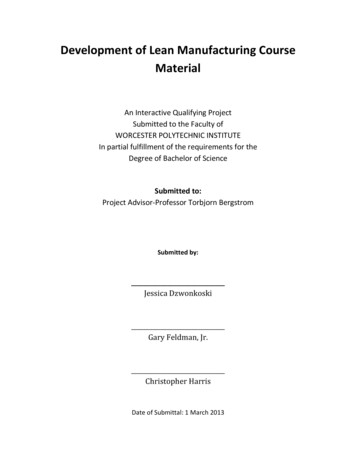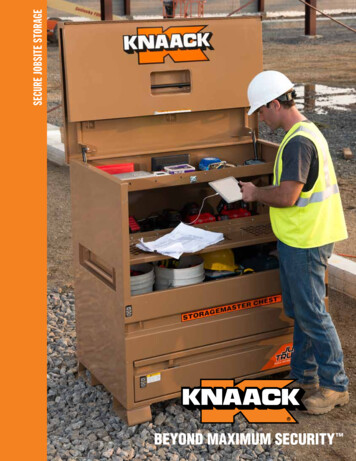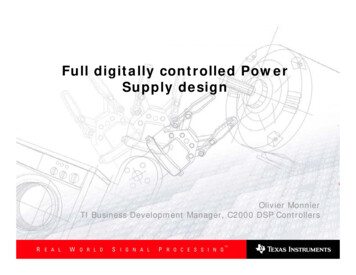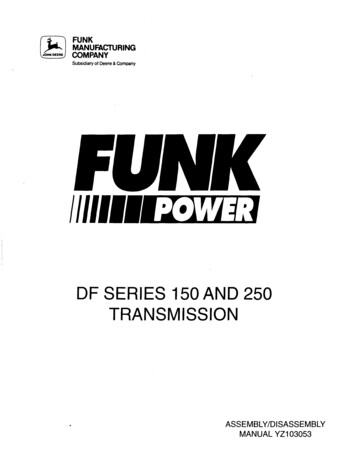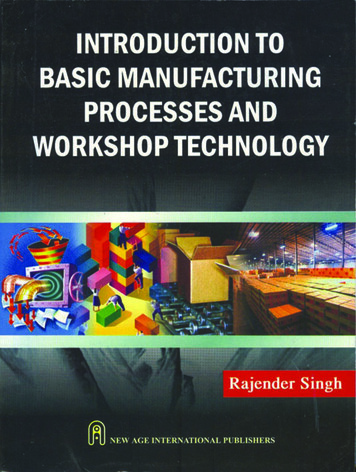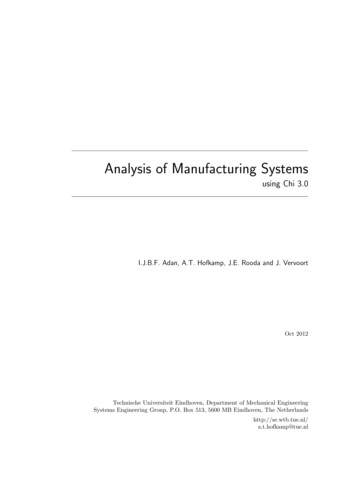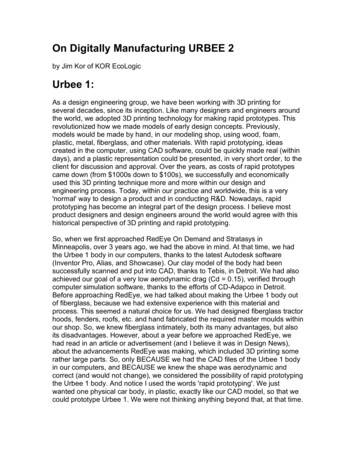
Transcription
On Digitally Manufacturing URBEE 2by Jim Kor of KOR EcoLogicUrbee 1:As a design engineering group, we have been working with 3D printing forseveral decades, since its inception. Like many designers and engineers aroundthe world, we adopted 3D printing technology for making rapid prototypes. Thisrevolutionized how we made models of early design concepts. Previously,models would be made by hand, in our modeling shop, using wood, foam,plastic, metal, fiberglass, and other materials. With rapid prototyping, ideascreated in the computer, using CAD software, could be quickly made real (withindays), and a plastic representation could be presented, in very short order, to theclient for discussion and approval. Over the years, as costs of rapid prototypescame down (from 1000s down to 100s), we successfully and economicallyused this 3D printing technique more and more within our design andengineering process. Today, within our practice and worldwide, this is a very'normal' way to design a product and in conducting R&D. Nowadays, rapidprototyping has become an integral part of the design process. I believe mostproduct designers and design engineers around the world would agree with thishistorical perspective of 3D printing and rapid prototyping.So, when we first approached RedEye On Demand and Stratasys inMinneapolis, over 3 years ago, we had the above in mind. At that time, we hadthe Urbee 1 body in our computers, thanks to the latest Autodesk software(Inventor Pro, Alias, and Showcase). Our clay model of the body had beensuccessfully scanned and put into CAD, thanks to Tebis, in Detroit. We had alsoachieved our goal of a very low aerodynamic drag (Cd 0.15), verified throughcomputer simulation software, thanks to the efforts of CD-Adapco in Detroit.Before approaching RedEye, we had talked about making the Urbee 1 body outof fiberglass, because we had extensive experience with this material andprocess. This seemed a natural choice for us. We had designed fiberglass tractorhoods, fenders, roofs, etc. and hand fabricated the required master moulds withinour shop. So, we knew fiberglass intimately, both its many advantages, but alsoits disadvantages. However, about a year before we approached RedEye, wehad read in an article or advertisement (and I believe it was in Design News),about the advancements RedEye was making, which included 3D printing somerather large parts. So, only BECAUSE we had the CAD files of the Urbee 1 bodyin our computers, and BECAUSE we knew the shape was aerodynamic andcorrect (and would not change), we considered the possibility of rapid prototypingthe Urbee 1 body. And notice I used the words 'rapid prototyping'. We justwanted one physical car body, in plastic, exactly like our CAD model, so that wecould prototype Urbee 1. We were not thinking anything beyond that, at that time.
Our concern as we approached Stratasys was, "Could they rapid prototypepanels large enough to do the entire Urbee body?" We were worried aboutgetting sidetracked in a separate and potentially lengthy R&D project dealing withjust the car body, and this is something we, the Urbee team, did not want to do.Mainly because the car itself, beyond the car body, needed all of our team's R&Dfocus. And, the other option, a fiberglass body, contained zero risk for us, just alot of meticulous and lengthy hand-work in our shop. Lucky for us, we met JeffHanson at RedEye On Demand, the visionary behind the company. After severalmonths of back and forth discussion with Jeff and others at RedEye, includingmulling over the many details that needed considering, we at KOR EcoLogicpartnered with RedEye and Stratasys in making the Urbee 1 body. We carefullyand cautiously proceeded in this direction knowing that it would begroundbreaking, but also knowing it was doable. We chose this directionbecause, as product designers, we were well aware of the advantages of rapidprototyping (accuracy, speed, etc.), as compared to the disadvantages of goingwith a fiberglass body (tooling, lengthy hand-work, toxicity, etc.). And with theUrbee 1 car body already in our computers, with all that hard work already done,this seemed the right way to go: . just print out one car body, and that part of theUrbee prototype would be ready to go.The 3D printing method we decided upon is called Fused Deposition Modeling(FDM). Think of this process as a very sophisticated, computer-controlled gluegun that creates the part, layer by layer, from the bottom to the top of the part.The computer program takes its fundamental instructions from the original CADmodel. In our case this would be the fender, body panel, or glass window we haddesigned for Urbee 1. The part starts out in the form of a continuous roll of plasticof round cross section, about the diameter of a single spaghetti noodle. This rollis fed into the 3D printer, and that noodle is what goes IN to the head of the gluegun. But the plastic string that comes OUT of the glue gun, which is building thepart layer by layer, is about the diameter of a human hair. So, amazing detail canbe built into the 3D printed part, along with amazing accuracy. In this way, theFDM 3D printers tirelessly make parts, without any human intervention requiredfrom start to finish.The incredibly talented people within RedEye and Stratasys made this first-ever3D printed car body happen. Our contacts were: Jeff Hanson, Joe Hiemenz, andNoah Zehringer, and it became a true pleasure working closely on Urbee withthese people. Jeff, Joe, and Noah are masters of innovation. They successfullyovercame the numerous issues that a project like this can uncover as it movestowards completion. Our strategy was to first make a 1/6th scale model, cut upexactly like the real car would be in its 20 separate panels, which included all ofthe body components and all of the window templates (see illustration attached).
Once the 1/6th scale model was 3D printed and everything fit perfectly, we wereassured that the 20 separate computer files were correct. Making the 1/6th scalemodel was routine rapid-prototyping, commonly done, with nothing special aboutthe process, or the size of the parts. Then these exact same computer files thatmade the 1/6th scale model were scaled up. Only then did we attempt the large,full-size pieces for the Urbee body, using the same files that made the scalemodel. In this way, we knew that all of the large panels would fit perfectly, firsttime out of the printers. This is a very important consideration, because of howlong it takes to print large parts (days instead of hours), and the need to avoidmistakes within these very large parts.As we received full-size body panels from RedEye, we mounted these onto theUrbee prototype chassis. We also used the solid plastic 3D printed windowpanels as templates in making the glass and plastic windows that ended up inthe prototype car. We used white ABS plastic for the exterior 3D printed body ofUrbee 1. During the printing process, some parts required the water-soluble greyplastic used to support certain overhanging areas of white plastic. Our initial goalwith Urbee 1 was just to see if we could actually make (3D print) and handlethese large panels, and turn them into a car body. Worried they might be weak,we made the full-size parts rather thick, about 0.25 inches. We added simpleegg-crate stiffening structures on the inside. Nothing fancy, just some bracing.The parts were a bit heavy, but not excessively so, and they ended up being very
strong. I've attached a photo of one of these big parts, just as it was finishedbeing printed and joined together (see below).URBEE 2:For URBEE 2, parts will be designed more carefully as 3D parts that includeexterior skin, interior skin, and lots of components integrated in between. I haveattached some photos of our preliminary front bumper. Exact material choice hasnot been made at this time, but it will be some form of recyclable plastic.Although not essential, we are considering weaving two materials together into amesh designed to handle the forces the part must withstand over time. Onematerial would be very strong yet brittle, combined with another material that isless strong yet elastic. This is similar to how bones in animals are constructed, orshould I say 'grown'. In animal skeletons, this combination provides very strongyet durable structures. Bone strength approaches many of the best man-madematerials, while utilizing basic life-elements. Stratasys 3D printers can print twodifferent materials at the same time, so require no modification to do thisinterwoven structure. We just need to design for it in CAD, and understand theforces enough that we can follow these within the part.
We are at a very early stage with these considerations. But, we are hopeful thatwe will make significant progress, especially working hand-in-hand with RedEyeOn Demand / Stratasys, as we plan to in the coming years ahead. With the rightpeople involved, we believe we will eventually accomplish incredibly strong,amazingly durable, and 100% recyclable parts. These will be parts that are ofamazing complexity, but will be much fewer parts than normal, as we integratenumerous functions within each single part.
The Promise of Digital ManufacturingFor Urbee 1 we were only thinking of rapid prototyping the body - just one bodyfor one prototype car.For URBEE 2, we have made a mental leap. We are now designing the car sothat the major body and interior parts (about 40 to 50 parts in total) MUST bemade by the 3D printing process. No other process will be able to make parts ascomplicated as we plan to design. This is quite different than rapid prototyping afew parts. This designing exclusively for 3D printers has been termed DigitalManufacturing. We expect to manufacture these parts in a 'factory of the future'that houses many 3D printers, all mass producing production parts.Many production parts are already being Digitally Manufactured NOW, especiallywithin the military aircraft industry. Also, car corporations are selling DigitallyManufactured parts NOW within some of their more specialized vehicles, wherelow volumes don't warrant the higher cost of tooling up for the part. So, DigitalManufacturing is here now, and will only broaden in scope, as costs continue tocome down.Our reason for embracing Digital Manufacturing is that, once you are able tobuild ANYTHING, then, as a designer, you can start to think of ALL POSSIBLESolutions. This is incredibly liberating, and will allow for better and better overalldesigns to emerge into production. There are four technological fields ofsignificance that will allow further exploration into finding ALL POSSIBLEsolutions. These are:1. Digital Manufacturing (3D printing used for production manufacturing)2. Simulation Software (using the computer to mimic and understand the realworld)3. High Performance Computing (using massive computer power to derive allpossible solutions, even the ones 'never thought of', similar to how evolutionprogresses)4. Biomimicry (learning from Nature and employing what is learned within ouremerging sustainable technologies).These, in combination, hold the key to properly making things on Earth, or whatcould be called 'designing for sustainability'.And this is what excites us about the future.Digital Manufacturing has opened the door to the potential of economically andcleanly building almost ANYTHING.And the ability to economically build almost ANYTHING allows thinking of almostEVERYTHING (every possibility).
And this will allow for BETTER and BETTER designs -- ones that cansuccessfully co-exist within the natural landscape, without inflicting damage.To us, this seems like the right way forward, and the right thing to do. AlongsideRedEye On Demand and Stratasys, we've started on this journey. We'recommitted and we're doing it. Just watch us now."URBEE 2,San Francisco to New York,two people and a dog,10 Gallons of fuel,just by hitting Print."- quote by Laura Betker, Simply Science, KARE 11, Minneapolis, USAURBEE's trip across America is planned to occur in about 2 years (Spring, 2015)Jim Kor, P.Eng.PresidentKOR EcoLogic Inc.Winnipeg, ManitobaCanadajimkor@mts.netwww.URBEE.net
'normal' way to design a product and in conducting R&D. Nowadays, rapid prototyping has become an integral part of the design process. I believe most product designers and design engineers around the world would agree with this historical perspective of 3D printing and rapid prototyping. So, when we f


